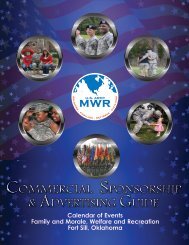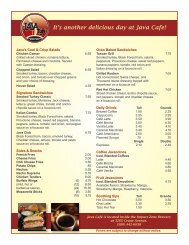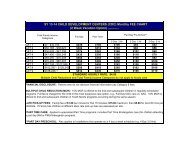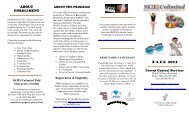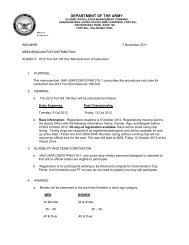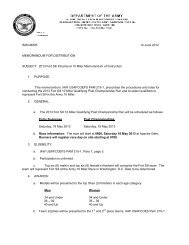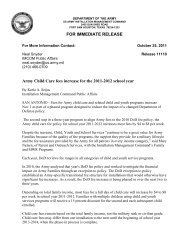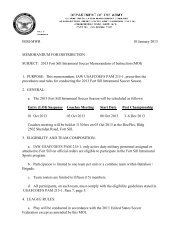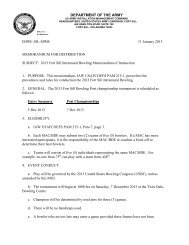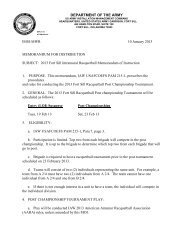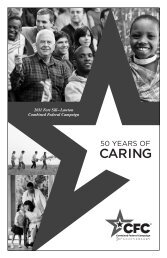Preparing and Managing Correspondence - Fort Sill MWR
Preparing and Managing Correspondence - Fort Sill MWR
Preparing and Managing Correspondence - Fort Sill MWR
Create successful ePaper yourself
Turn your PDF publications into a flip-book with our unique Google optimized e-Paper software.
. Parts, sections. <strong>Correspondence</strong> in which subjects are lengthy or require subdivision for clarity may be divided<br />
into parts, sections, or similar subdivisions as desired by the originator, the subdivisions being identified by Roman<br />
numerals, Arabic numerals, or capital letters. When this is done, the actual paragraph numbering sequence should still<br />
be continuous throughout to facilitate identification.<br />
c. Group titles. Group headings may be used to head one or more paragraphs, which may or may not themselves be<br />
headed, relating to the same general subject. Group headings should be capitalized <strong>and</strong> underlined <strong>and</strong> should not be<br />
numbered.<br />
d. Paragraph <strong>and</strong> subparagraph headings. Where it is desirable to give a paragraph or subparagraph a heading, this<br />
heading will be printed in lowercase letters (with the first letter of each major word capitalized), underlined, <strong>and</strong> placed<br />
in the first line of text.<br />
F–6. Close<br />
a. Contents. The close must always contain the signature block. The close will also contain a comm<strong>and</strong> or authority<br />
line when the signature block does not show the comm<strong>and</strong>er or authority by which the correspondence was issued.<br />
b. Signature block. The signature block must always include a h<strong>and</strong>written signature on the original, with the<br />
individual’s name <strong>and</strong> rank (if military), typed, printed, or affixed by means of a rubber stamp on the original <strong>and</strong> all<br />
the copies. When the signing authority is not the one mentioned in the head of the correspondence, the signature block<br />
should contain the words for, by delegation, or the equivalent.<br />
F–7. Supplementary documents<br />
a. Annexes. Supplementary documents that amplify or explain the parent document are called annexes. They are<br />
used when the inclusion of all the detail in the body of the document would make it cumbersome. Annexes should—<br />
(1) Be introduced or referred to in the body of the correspondence.<br />
(2) Be lettered consecutively using uppercase letters in the order in which they appear in the text. A single annex is<br />
Annex A.<br />
(3) Have their own subject headings.<br />
b. Appendixes. Supplementary documents that amplify or explain annexes are called appendixes. They are used<br />
when the inclusion of all the detail in the annex would make it cumbersome. Appendixes should—<br />
(1) Be referred to in the text of the present annex.<br />
(2) Be identified with uppercase letters in alphabetical sequence (for example, Appendix A, Appendix B). Identify<br />
paragraphs within an appendix with an uppercase letter <strong>and</strong> an Arabic number. The letter represents the appendix; the<br />
number represents the numerical sequence of the paragraph within the appendix (for example, A–1, B–1, B–2). Tables<br />
or illustrations within an appendix will be identified with an uppercase letter <strong>and</strong> an Arabic number. The letter<br />
represents the appendix; the number represents the numerical sequence of the illustration or table in the appendix (for<br />
example, Figure A–1, Figure A–2, Table A–1, Table A–2).<br />
c. Enclosures. Supplementary documents that are complete in themselves <strong>and</strong> are forwarded with military correspondence<br />
are referred to as enclosures. Enclosures may have their own annexes <strong>and</strong> appendixes.<br />
d. Listing <strong>and</strong> identification. Documents that supplement a piece of correspondence are listed <strong>and</strong> briefly identified<br />
under a separate item either in the head or the close. Annexes <strong>and</strong> appendixes should refer to the parent paper so they<br />
can be identified.<br />
F–8. Tabulation<br />
It is frequently necessary to present information, especially in supplementary documents, in tabular form. In order to<br />
facilitate precise reference to items in a table, the insertion of amendments, lines, <strong>and</strong> columns will be identified as<br />
follows:<br />
a. Lines (or where appropriate, individual items containing more than one line) with a serial number (Arabic<br />
numeral) in the left-h<strong>and</strong> column. If serials need to be subdivided, subserials will be identified in the same way as<br />
subparagraphs.<br />
b. Columns (including those containing the serial number) with lowercase letters in brackets, which should be on a<br />
separate line below the column heading. The column heading itself need not be repeated on subsequent pages.<br />
F–9. References<br />
References to other correspondence may be listed either in the heading or in the beginning of the body of correspondence.<br />
When it is necessary to make reference to another document, identification will be in sufficient detail to avoid<br />
possible confusion. When referring to military correspondence, the reference will contain the following information:<br />
office of origin, identifying reference, date, <strong>and</strong> subject of correspondence.<br />
100 AR 25–50 • 3 June 2002




